The AOC AGON AG276QZD is a colour-accurate, rapidly responsive and mightily impressive 27” gaming OLED
- Manufacturer: AOC
- Model: AGON AG276QZD
- SKU:
- Display Type: OLED Gaming Monitor
- Resolution: 2560*1440
- Refresh rate: 240 Hz
- Price when reviewed: £849
- Supplied by: AOC
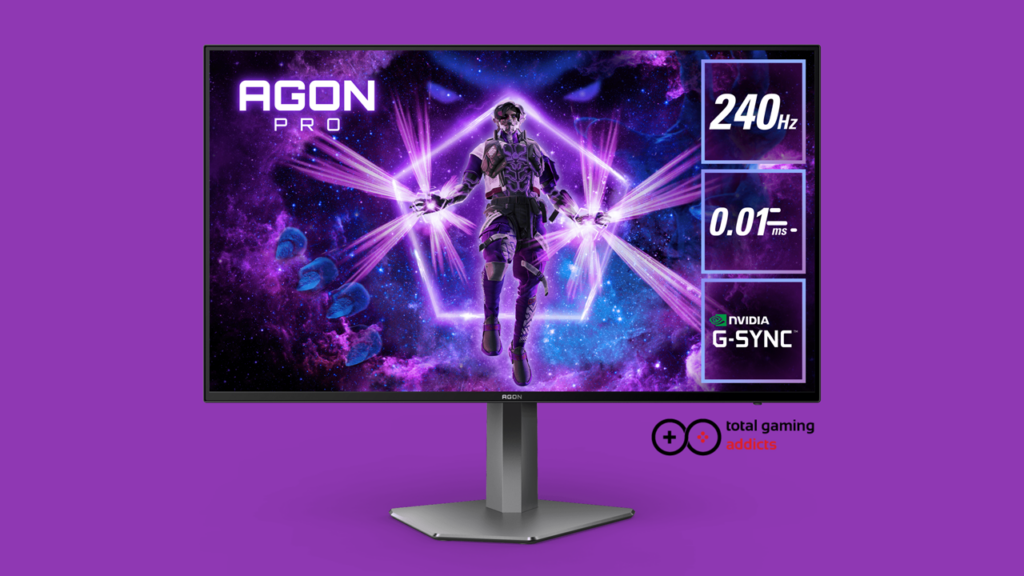
AOC AGON AG276QZD Review
Overview
OLED has been making waves in the TV space for many years, but the technology has only recently started popping up in gaming monitors. For us gamers, we’re at the point where VA and IPS tech has been refined so much that, aside from developments like full-array local dimming and micro-LED, the year-on-year improvements are subtle. OLED tech is far more significant for gamers, bringing incredible responsiveness and superior picture quality into the mix. The AGON AG276QZD is AOC’s first OLED gaming display, and this one is geared towards competitive gaming with a 1440p resolution and 240Hz refresh rate. It’s pretty damn good, too.
For its intended primary purpose of gaming, it’s hard to fault the AG276QZD. Frames win games, and when you’ve got such rapidly produced frames with minimal blur and no perceivable latency, you’re getting an outrageously good gaming experience. 27” screens are hugely popular with competitive gamers, and at that screen size, 1440p strikes a pretty good balance between sharpness and achievable performance.
If you’re looking at a monitor in this price range, chances are you’ve got a PC capable of pushing the AG276QZD up to its maximum 240Hz refresh rate. There’s a bit of competition in this format, but with prices currently around £849 for the AG276QZD, you can save quite a bit of money (around £200 less) by not paying the ROG tax.
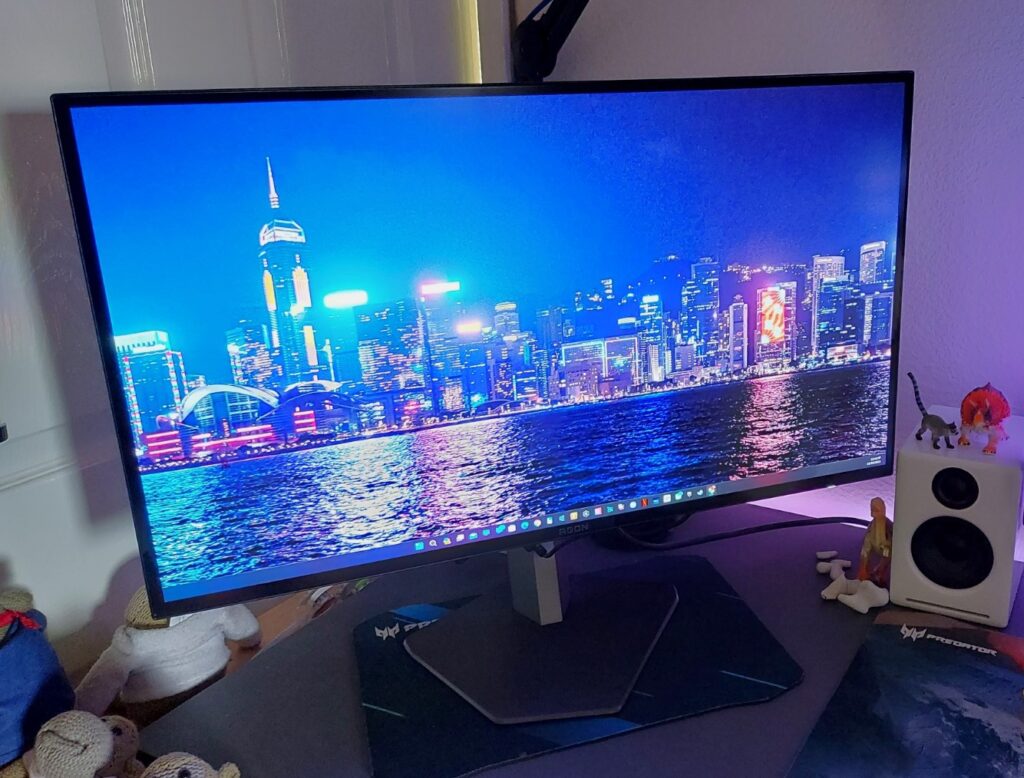
Out of the box, the AG276QZD is excellent, with a solid factory calibration that needed no adjustment outside of a minor tweak to the RGB sliders to slightly correct the white point (default was 6380K using the Warm preset). Because this is an OLED, the black levels drop to literally zero, so even though peak brightness is nothing to write home about, the essentially infinite contrast means that perceived brightness is far greater. Whether you’re watching videos or playing games, the AG276QZD looks stunning, however, the uncommon WRGB pixel array results in fine text looking slightly fuzzy, though it’s not something that bothered me in regular use.
The AG276QZD has a couple of quirks that I encountered, mostly stemming from the automatic brightness dimming (Called LBC (local brightness control) by AOC). On small areas of the screen with an APL (average picture level) below 30%, the brightness peaks at over 375 cd/m² in SDR, but when the whole screen is illuminated, especially with light colours, the screen hits the peak then can swiftly dim to as low as 225 cd/m². The AG276QZD does this to prevent the decline of brightness over time and avoid possible image retention. Many other OLEDs use a similar effect, but the AG276QZD seems to lower the brightness with a shorter delay and with a more sudden drop rather than gradual dimming.
It wasn’t until performing our display benchmarks that I noticed this phenomenon, as it mainly affected my colourimeter results, skewing the gamma, contrast and colour accuracy results. When gaming and watching movies, huge bright scenes are less common, and I didn’t notice any significant sudden dips in brightness.
Note: After testing, I learned that you can turn on uniform brightness mode in the monitor’s settings, which locks the peak brightness to the lower 225 cd/m² value and stops the brightness limiter from operating. However, this prevents the monitor from reaching the >375 cd/m² highs – I’d recommend leaving it off when watching media or gaming, and switching it on when you’re browsing the internet or working. Unfortunately, I didn’t have a chance to re-run our tests before returning the AG276QZD, so we don’t have the visual charts that we would usually publish.
Design and build
Continuing AOC’s shift to more environmentally conscious working practices, the AG276QZD comes in moulded cardboard packaging rather than polystyrene. It’s great for the environment, and as a consumer, it’s so much easier to squash cardboard into the recycling box rather than snapping up a huge lump of unrecyclable foam that showers your house in tiny bits of polystyrene confetti.
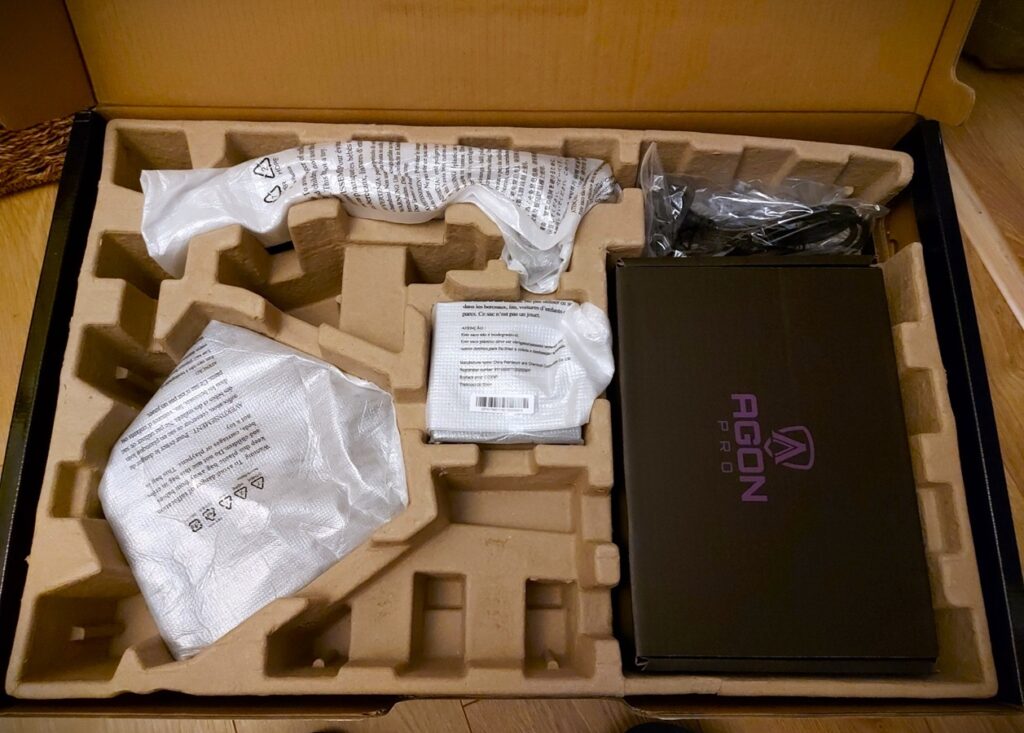
AOC has broken away from the usual tripod stand and red accents, fitting the AG276QZD with an asymmetric hexagonal RGB array at the rear and a matching-shaped stand base. I absolutely love the smaller footprint of the stand and how it sits flush with the desk, but I’m undecided on the asymmetric shape. AOC states that the skewed hexagonal shape is designed to allow more space for the mouse when playing eSports titles, and I can see that being the case for some pro-level high-DPI players, but it was mostly irrelevant for my amateur abilities.
The stand has grown on me over the past month, though, especially once I added my usual desk bling. I’m a huge fan of how small and flat the stand is, but the OCD-triggering shape may not be to everyone’s taste. If you’re in the latter camp, the AG276QZD is VESA mount compatible if you’d prefer to switch it out or use a monitor arm, and it also has an included VESA bracket that attaches the same way as the included stand; I much prefer this method over having four screw holes directly on the rear of the monitor.


Despite any potential misgivings regarding the shape of the base, the two-piece stand is easy to assemble and rock solid. It’s a huge improvement over AOC’s chunky tripod stands that tend to dominate your desk space. Ergonomically, you can tilt the display -5/+23 degrees, swivel +/- 30 degrees, pivot 90 degrees in either direction and adjust the height by 130 mm.
With no LED backlight to fit in, the panel is very thin at the edges with exceptionally slim bezels. It’s a little thicker at the rear to allow for the PCB and all of the inner workings, but the design looks premium, and I love the subtle touches like the contrasting grey accents and the diffused RGB lighting. The RGB isn’t bright enough to provide bias lighting, so unless your desk is positioned so that you can see the back of your monitor, you can always turn it off to save a bit of energy.
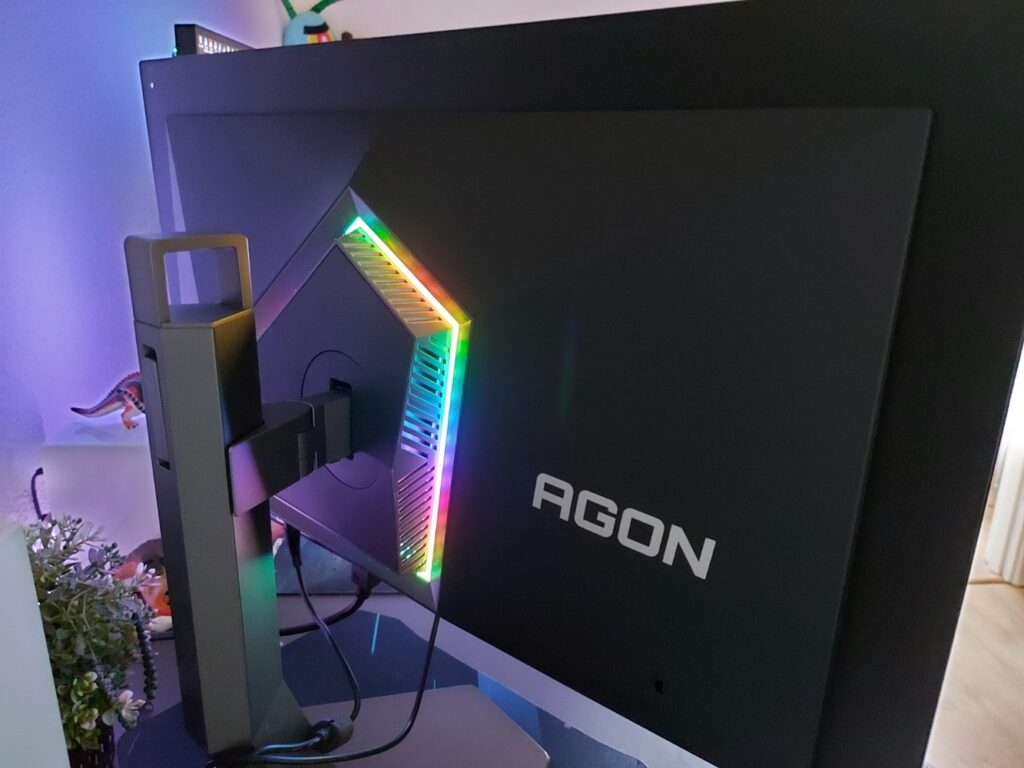
I’ve gotten used to integrated power adapters, so I’m always a bit disappointed when displays come with a power brick that needs to be cable-managed, but due to the relatively low power consumption (35W typical), the power brick is very small and easy to tuck away or place on a cable tidy beneath your desk.
The control joystick at the rear is easy to reach and responsive, but I would have liked to see AOC include their excellent quick switch controller, especially at this price point. AOC’s AGON UI is looking even more dated now, and I would have liked to see some kind of update now that they are producing OLED displays. It’s a little jarring having state-of-the-art tech and then a red, low-res menu system. It’s not particularly a complaint, though; I’ve been using the AGON UI on my main display for years now, and the menus are sensibly arranged, easy to navigate and the most important features are just a couple of clicks away.
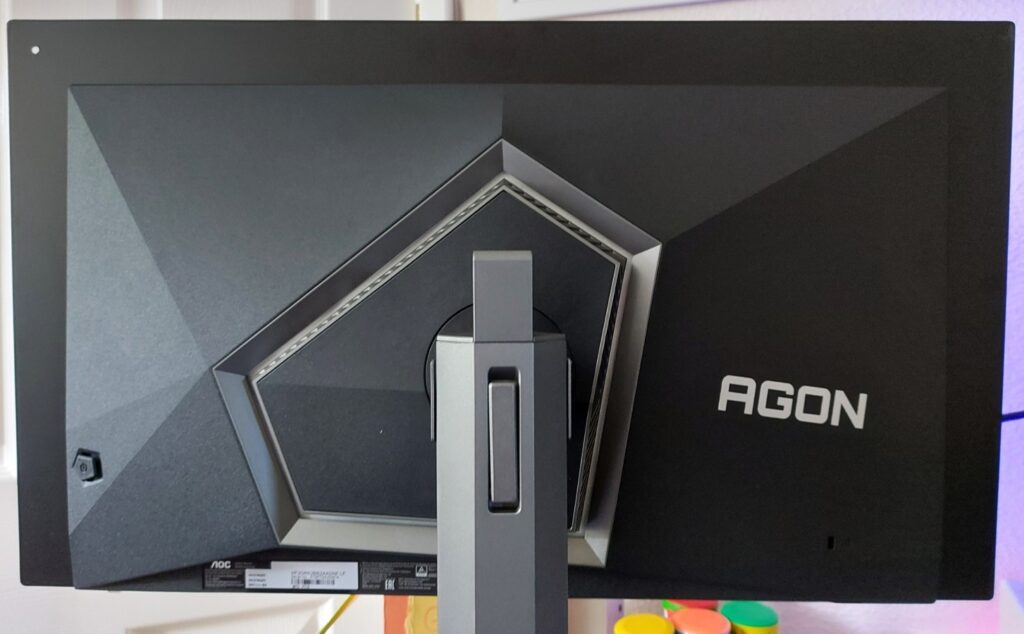
Connectivity and Supported Resolutions
The AGON AG276QZD has 2x HDMI 2.0 and 2x DisplayPort 1.4 for display connections to your PCs, laptops and consoles, along with a 3.5mm audio out and a USB 3.2 Gen1 hub with 2 downstream USB-A ports (including one fast-charge port, coloured yellow).
The AG276QZD supports the following optimum resolutions:
HDMI 2.0: 2560*1440 @ 144 Hz
DisplayPort: 2560*1440 @ 240 Hz (with DSC)
As the AG276QZD only supports HDMI 2.0, you are restricted to 144 Hz via HDMI, and DP connections require a DSC-compatible GPU to hit the full 240 Hz.
The AG276QZD is certified G-Sync compatible, as well as supporting FreeSync, with an adaptive sync window that spans 48-240 Hz via G-Sync and 48-144 Hz via FreeSync; When using G-Sync, I occasionally encountered some slight flickering – I tried to pinpoint the exact cause, but it was difficult to replicate.
It seemed at first to be related to running Netflix through a browser on a second monitor, as Netflix is known to have issues with G-Sync interfering with DRM. After closing and reopening Netflix it was okay for a while, until I loaded up Destiny 2 (after grabbing the free DLC from the Epic Games Store), and found the flickering to occur during the menu screens. It seems a few others have reported the same issue, so hopefully, it’s something that can be addressed in a firmware update. I would note that it didn’t occur during gameplay, and I only experienced it a few times in over a month of use, but it’s worth mentioning.
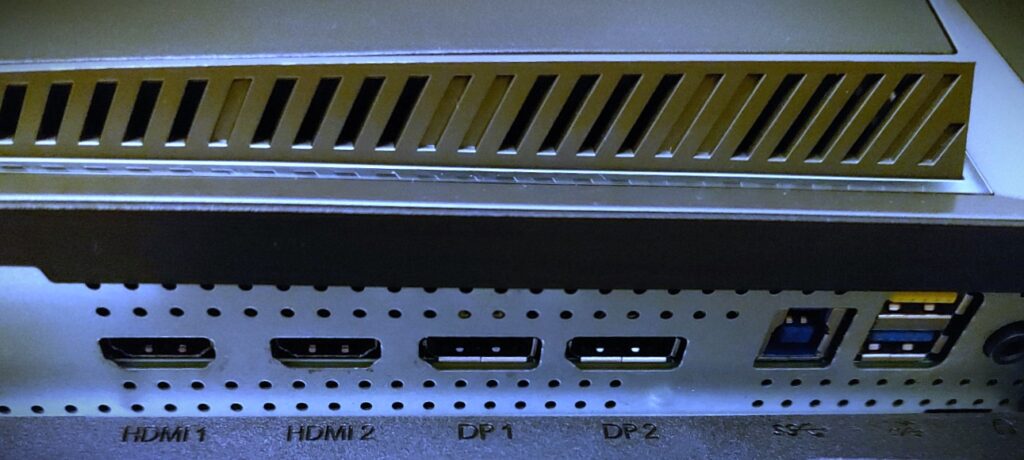
I regularly use the USB hubs on my monitors, so I’d have preferred to have a four-port hub, but space is limited by the slim panel. There’s also no USB-C port, which would have been handy when using laptops and KVM, or in my case, for putting the otherwise unused USB-C port on my MOBO to use. It shouldn’t be a deal breaker, but if you regularly use a gaming laptop you likely won’t have the full refresh available as most have HDMI and/or USB-C display outputs, rather than DP.
Both PIP and PBP are supported, and they worked as intended in our testing. The lack of KVM dampened the usefulness of PBP, but I had no issues with image scaling or compatibility with my test devices. I’ve just come from using a 49” OLED, so I found the PIP window to be either too small for comfortable viewing or so big as to obscure an important part of my desktop, but again, it worked as intended.
Good quality 1.8m DisplayPort, HDMI and USB-B to USB-A cables are provided, along with the compact power brick, so you’re ready to get up and running straight away.
Display quality
I’ve been using a mixture of OLED and IPS displays for the best part of a year now, but it’s getting harder and harder to go back to LCD. No matter what I’m doing on my PC, it invariably looks better with OLED. We’ve also now reached the point where not having an OLED, especially for competitive gaming, almost puts you at a disadvantage.
The AG276QZD is simply outstanding when it comes to high-refresh-rate gaming. Even the best IPS monitors can’t match the responsiveness of this display. As for picture quality, local dimming mini-LED displays are great, but against the true blacks of this OLED, there’s no competition.
This display isn’t perfect, but it’s not far off. The automatic brightness limiting comes on a little too aggressively, and the peak brightness is only so-so, but it excels in almost every other area. Considering OLED monitors are still in their infancy, the AG276QZD is a superb example of the potential of this tech in the gaming space.
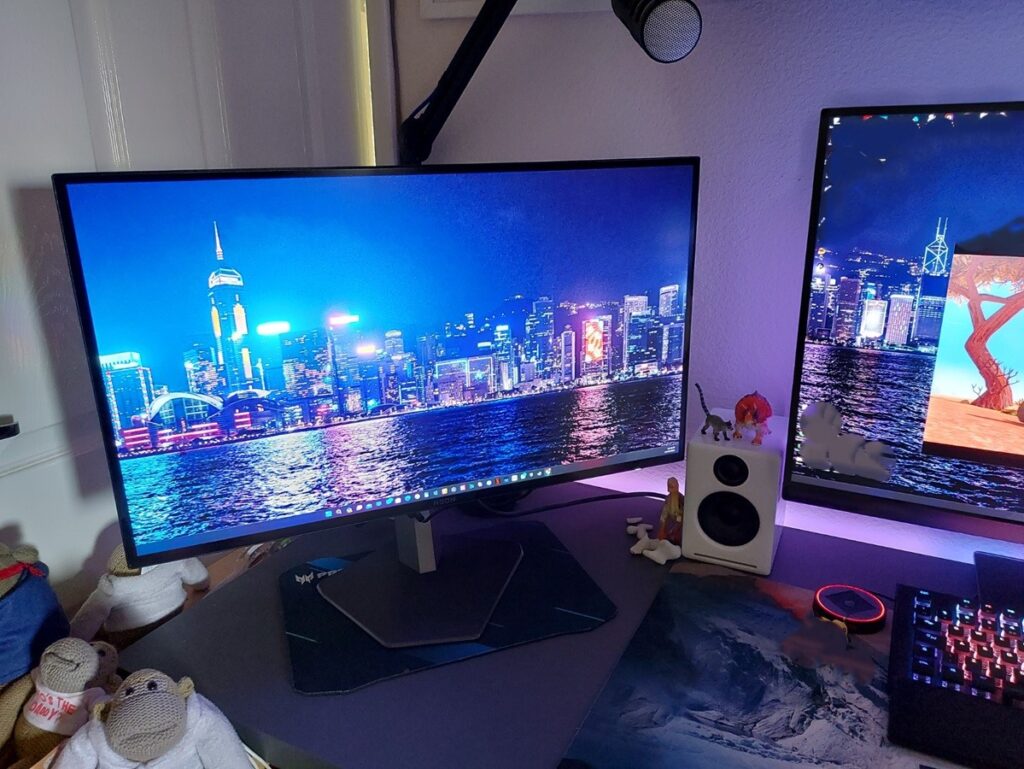
OLED panel care
OLED burn-in is a concern for many, but AOC has included several features to help mitigate the potential for burn-in. Pixel orbiting is a common solution, which shifts the pixels of the image sequentially, once a second in a circular pattern. It sounds like it should be hugely distracting, but I didn’t notice it occurring and had no idea it happened so frequently until I read through the documentation. You can turn this off, but the default weak setting didn’t bother me (setting it to strong can move elements of your image off-screen). TPC (Temporal Peak Luminance Control) is a fancy name for screen dimming. If you leave a static image on your screen, it will gradually lower to around 25% brightness.
The most intrusive of these panel care technologies is panel refresh, which displays a warning after four hours of continuous use. It stays on the screen for a few seconds before automatically dismissing if you don’t press the joystick, but if you do want to perform a refresh, I found the auto-warning didn’t always stay on for long enough to hit the button in time, but there is a manual refresh option if you miss it.
If you don’t perform the refresh, a reminder will pop up once every hour until you do the refresh. If you choose to ignore the reminders or turn off the auto warning (which is what I would do if it was my monitor), the panel will automatically perform a refresh once you power off with the button, or after two hours in standby mode, so it’s something you can mostly forget about without interrupting your gameplay or fearing for your monitor’s safety.

I would note that any burn-in issues I’ve heard of are purely anecdotal – outside of a few YouTube videos or forum posts, I haven’t seen first-hand evidence of its occurrence. I’m not saying it doesn’t happen, but despite the initial concerns, burn-in seems to be far less prominent, especially if you take sensible preventative measures like using a screen saver and running the panel refresh routinely.
A note regarding OLED gaming: The only use case where I’d express concern is for those who religiously and exclusively play the same game for countless hours each day, which is especially relevant for a pro-gaming display. When HUD items like crosshairs, scoreboards and other static on-screen elements are always in the same place, this is one of the situations where burn-in becomes more likely. I haven’t used an OLED panel for long enough to categorically state how this may or may not affect this display, but if you only ever play CS2, for example, and rarely use your PC for anything else, you may be one of the few users for whom a quality high-refresh LCD with ULMB may be the better option.
Panel response
The OLED panel in the AG276QZD is blisteringly fast, with most grey-to-grey transitions occurring in under a millisecond, and as with all OLED panels, the pixels can switch on and off so fast that you don’t need overdrive. Running the Blur Busters UFO test suite, the moving images were free from artefacts, and I couldn’t see any blur along the trailing edges. Even the best IPS displays running overdrive have a faint trail when running these tests, but this OLED is on the next level, with no overshoot or ghosting visible to the naked eye.
With under 20ms of latency, using the AG276QZD in multiplayer games almost feels like cheating. No matter how aggressive your movements everything stays pin-sharp and smooth, and the response when clicking your trigger feels instantaneous. With a display this good, the only limit is your own skill level.
Brightness, contrast and colour
Using the Native preset with a 30% white window, the brightness peaked at 378 cd/m², and with a full-screen white image, the display peaked at 234 cd/m². These are decent figures, and around the levels that I calibrate my daily driver IPS panel to, depending on the level of ambient light. Massive brightness levels are great for bragging rights, but in real terms, I’ll take the pure black of OLEDs any day. Those pure blacks also enable the AG276QZD to have ridiculously high levels of contrast, which makes a tangible improvement to anything you’re watching.
The AG276QZD is calibrated to an average DeltaE of 0.82, which is ideal for gamers and content creators alike. This is based on the included data sheet from AOC’s factory calibration; the brightness limiter appeared to interfere with our colourimeter results, which showed an average DeltaE that was off the charts and was clearly incorrect. However, based on side-by-side comparisons and previous AGON monitors we’ve tested, I’m confident that AOC’s stated results are accurate.
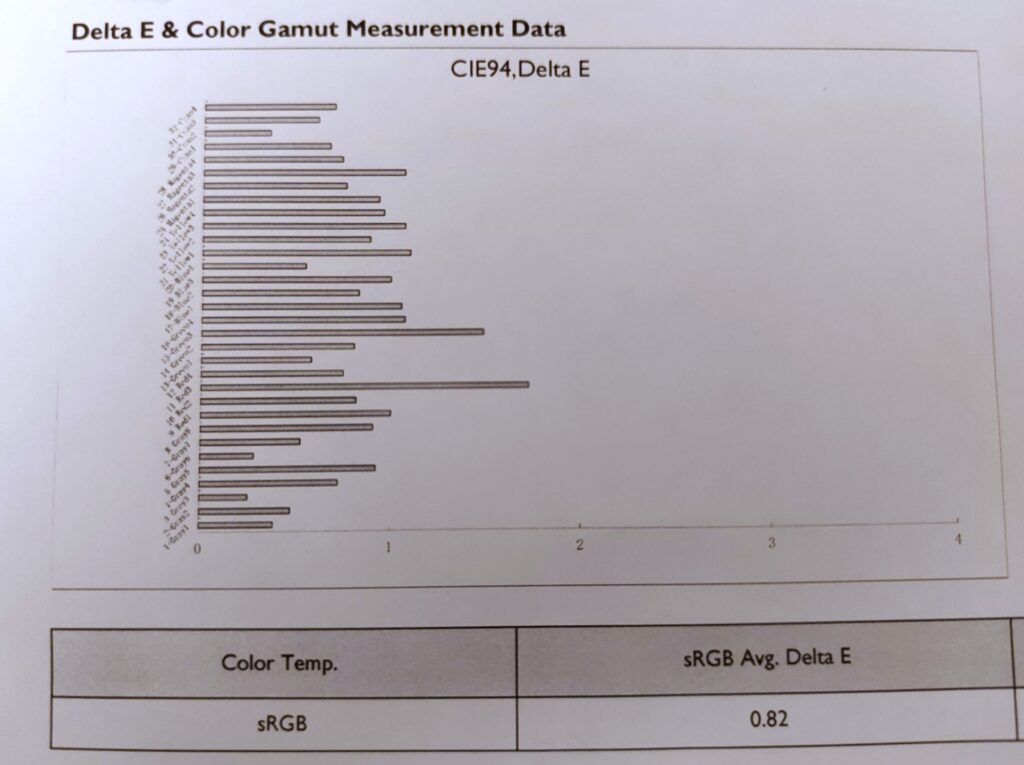
The aforementioned brightness limiter also interfered with our gamma test results, causing huge fluctuations on either side of the curve that didn’t correlate with what I was seeing. When using a more old-school visual check using the Lagom test, the displayed gamma appeared to comfortably follow the 2.2 range, as well as matching my calibrated AG324UX.
Gamut coverage and HDR
The AG276QZD has a gamut selector, offering native, DCI-P3 and sRGB options. Users who prefer sRGB will be pleased to know that full brightness adjustment is available in the DCI-P3 and sRGB colourspaces. The native setting uses DCI-P3, and I couldn’t find any visual difference between the native and specific DCI-P3 modes, so I’m not sure of the relevance of its inclusion.
Colour saturation and gamut coverage are very good, but still slightly behind some of the best monitors we’ve recently tested. This monitor has native DCI-P3 coverage, which tends to favour yellows and reds, but the coverage was very even, creating beautiful colours across the entire spectrum, with pleasingly deep saturation.

The panel in the AG276QZD has native 10-bit colour depth, allowing it to display up to 1.07 billion shades of colour. Gamut coverage* is above average, even if it doesn’t break any records.
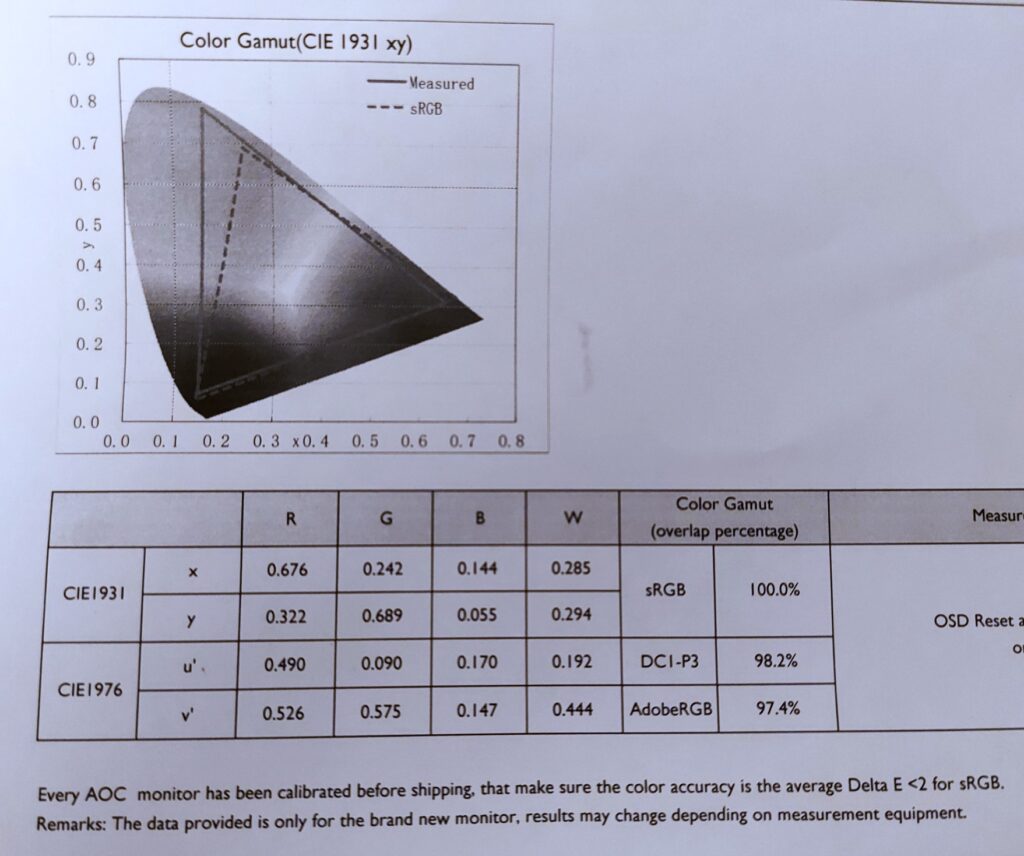
- sRGB 100% coverage – 139.1% volume
- AdobeRGB 97.4% coverage – 98.1% volume
- DCI-P3 98.2% coverage – 98.7% volume
*Coverage refers to how much of the specified area of the gamut is covered, whilst volume includes any colour that extends beyond the defined gamut.
I found HDR performance to be slightly lacking when it came to the bright highlights, though it can still briefly hit over 650 cd/m² in small areas, which appears even more striking against the true blacks of the OLED. The AG276QZD more than makes up for the lower brightness with excellent HDR colour accuracy and the amount of detail it can produce in the darkest areas.
The accurate DCI-P3 colour, intense saturation, and blistering grey-to-grey response make viewing HDR content a vivid and enjoyable experience. It may not be initially quite as impressive as a QD OLED or FALD LED display, but the HDR quality is still a huge step up from the AG276QZD’s SDR output and way better than any traditional VA or IPS display with <gags> HDR400.
Viewing angles and uniformity
Panel uniformity is exceptionally good, with minimal shifts in brightness and colour accuracy as you move around the display. Off-angle viewing is also excellent; Colour saturation, hues and brightness are maintained even at extreme angles, even viewed from above. Even though you are less likely to be sharing a 27” screen, the clarity at extreme viewing angles is mightily impressive.


Sound quality
The AG276QZD has 2x 5W speakers, which do a reasonable job. The low end is a bit thin, and at high volume, the overall sound can suffer from a muddling of frequencies when a lot is going on, but it’s fine for occasional use. As always, we recommend you budget for a great headset or a set of bookshelf speakers, but these aren’t the worst speakers we’ve heard by any stretch.
Summary
There’s a lot to like about the AG276QZD: The picture quality is fantastic, with wonderfully vivid and accurate colour, superb contrast, and blacks so deep you could drown in them. When it comes to gaming, the response is incredible, and the combination of a 27” screen, 1440p resolution, and a 240 Hz refresh rate is pretty much the benchmark for eSports pros. Throw in meaningful HDR support, and the AG276QZD is the complete package.
The speed at which the brightness limiter kicks in feels too fast and too sharp, but this only bothered me when viewing web pages or creating documents, and can easily be negated by using the screen uniformity setting (albeit with reduced brightness). There was also the slight flickering with G-Sync turned on, but on the rare occasions it occurred, it didn’t bother me too much (and could potentially be fixed with a firmware update).
There’s a bit of competition for the AGON AG276QZD, but its main competitors use the same panel, so any differences are likely to be minor. For many people, price is likely to be the key differentiator that sways their decision, and with the AG276QZD recently getting a price reduction, I can imagine a lot of people going for this monitor.

